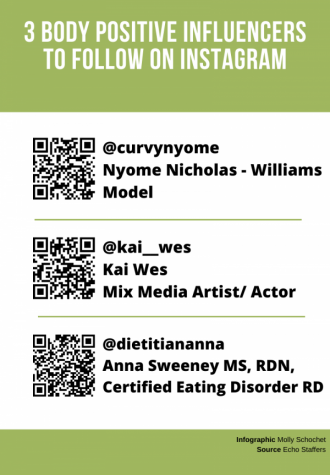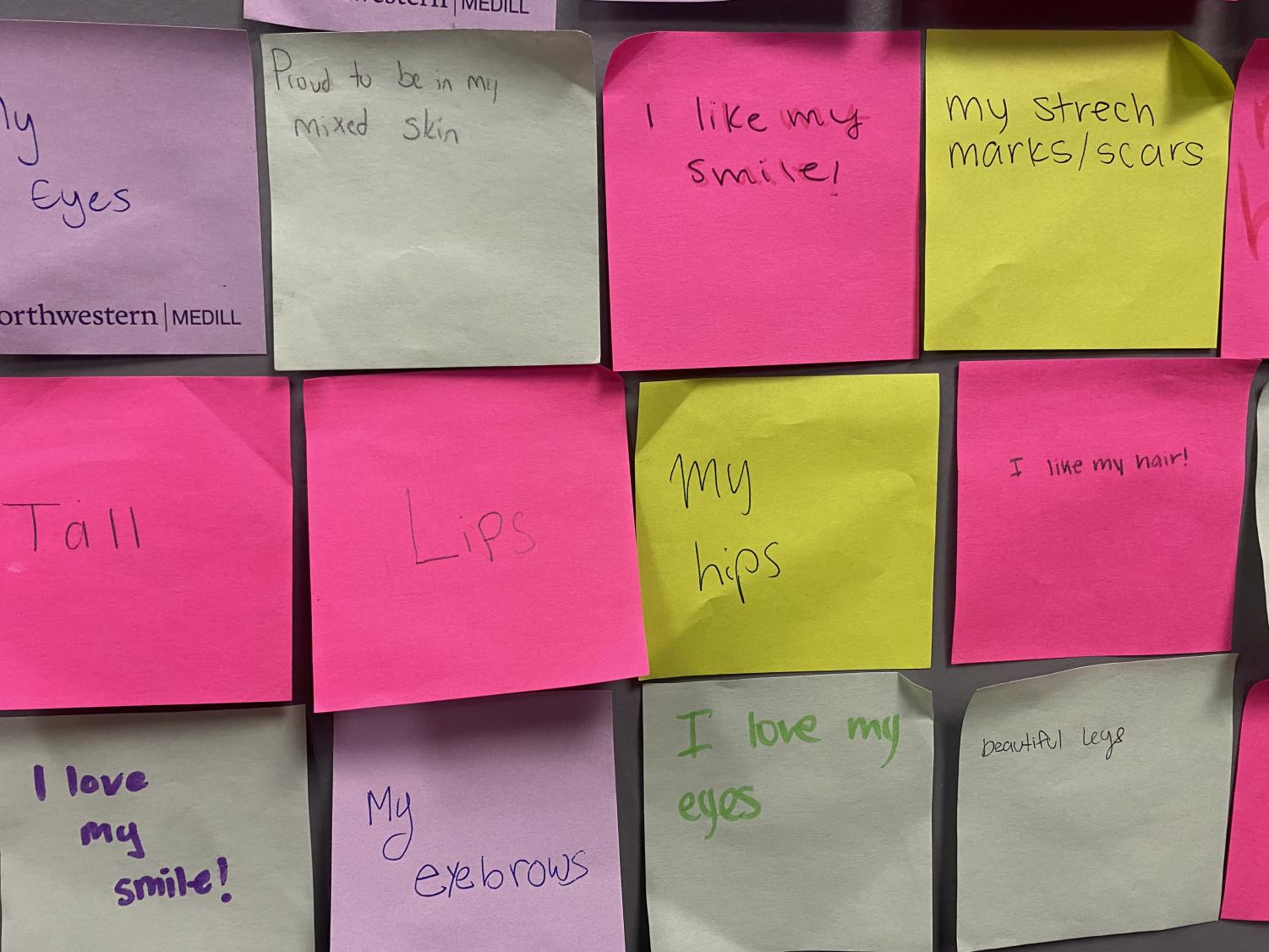The truth behind the posts
The impact of social media on the body-positive movement
March 23, 2021
Understanding the movement
Although her club focuses on empowering specifically women, junior and co-president of Girls United Ella Roether said the body-positivity movement still has a long way to go to ensure inclusive representation for all.
“A big part of it is (making sure) that all body types and skin colors and genders are represented,” Roether said. “It’s important to recognize that it’s not just women and it’s not just made for bigger women, everyone can participate in it and it’s not just for white women. I think that it’s important to make sure that the movement is intersectional.”
The body-positivity movement started to gain popularity around 2012, and the original idea behind the movement was to confront the senseless beauty standards that have been placed on women. For junior Symone Morrison, the body positivity movement is all about empowering people of all shapes and sizes.
“It’s something that we really needed as a society,” Morrison said. “For years, we put people down for what they looked like because it’s not what you see in magazines and on prints.”
Her experiences providing clothes for others has allowed Cat Polivoda, a fat-liberation activist and plus-sized clothing store owner, to spread body-positivity.
“I’m sure fashion is fun, but what I really care about is people being comfortable and confident in their bodies,” Polivoda said. “I found that clothes are a really good way into those conversations with people.
Body-positive social media influencer Brianna Tam has amassed over 4 million likes on TikTok. While her success rose because of her outspoken advocacy for self-love, Tam said her role in the community is still fluctuating as she continues on her journey through the movement.
“It’s a community that I’m a part of and trying to strengthen and bring attention to, but also I’m still learning from other people,” Tam said
Women are not the only ones who have faced unrealistic beauty standards. According to Health teacher Amy Pieper-Berchem, so have men, but they aren’t advocated for as frequently.
“It’s not only (affecting) women, it’s also (affecting) men, or people who fall anywhere really on the gender spectrum that are falling into these ideas of needing to look a certain way to be accepted,” Pieper-Bercham said. “Instead of getting better, it seems like now it’s crossing over where that pressure is really hitting more on the male gender, and it’s getting worse on this side.”
Influence of social media
While the majority of her experiences have been positive when using social media, Tam said some people use their platforms to spread negativity due to ignorance.
“(Social media) has really helped the movement but also with social media there is hate and you’re opening up yourself to be commented on by people who don’t understand the movement,” Tam said. “It does breed toxicity because some people are seeing ‘oh I can comment whatever I want because this person can’t see me and I can try to tear them down.’”
Her willingness to self-curate her social media feeds has led Polivoda to silence hate and have an overall positive experience on most platforms.
“There’s a lot of gross (stuff) on the internet or really fatphobic stuff or things that pretend they’re body positive but are really just damaging messages,” Polivoda said. “I have no qualms about silencing that, unfollowing, turning it off, reporting it whatever. I think because I take that strategy, I’ve had a really positive interaction with social media.”
While Morrison feels like the movement has been resonating with people, traditional beauty standards are still ingrained in our perception of ourselves. Additionally, while the movement may reject an old body standard, it can often adopt new ones that are enforced in the community through praise and popularity.
“With the whole movement, I feel like it’s finally starting to uplift people, but at the same time there’s always that one standard that people will initially hold you to. Because we have that, not everyone’s perfect and we still judge ourselves off of that one initial thought,” Morrison said.
According to Pieper-Berchem, the few individuals who do actively defend victims of cyberbullying are often left defeated.
“I see some things out there where people will actually stand up,” Pieper-Berchem said. “They’ll take a stand and they’ll demand that the photoshopping stop, they demand when somebody is bullying somebody or demanding that perfection. But again, they’re outnumbered.”
Social media has developed into a space that only showcases highlight reels of others’ lives which can cause unrealistic body and lifestyle expectations, according to Roether.
“The main part of social media is that it only shows the good parts of people’s lives and the perfect things. Posts are edited and use facetune filters so it’s not realistic in any way,” Roether said. “It’s still hard to see those things and also recognize those people don’t have a perfect life.”
For Tam, social media has allowed her to present a version of herself that is more true to who she really is.
“I’ve started to show my authentic body, unedited, stretch marks, all of that because I want other people to feel more comfortable doing that,” Tam said. “It comes with an individual responsibility to make it more casual, more authentic and make social media what it was intended for which was to show your authentic life to other people.”
Room to grow
Although Morrison said things are on the right track, advocacy for the movement can still be improved.
“I feel like we preach it more than we actually show it, and try to improve. You first have to start with yourself and then you can love others and show others that their body is perfect just the way they are,” Morrison said. “There’s a lot of improvement to do, but we’re heading towards the right direction.
The body-positivity movement is still struggling with representing marginalized groups within the greater community, according to Polivoda.
“There’s a lot of people still left out. We are replacing beauty standards but if you look at the face of body positivity right now in this moment, it is a lot of white women or maybe women of color with lighter skin tones who maybe are a little bit curvy or maybe a plus size, but in a quote unquote ‘curves in the right places” kind of way,” Polivoda said.
Standing up for someone can be a simple act that can cause people to be mindful of their actions Pieper-Berchem said.
“The biggest thing is to step in and to step up. It doesn’t have to be a big huge thing, but just one simple little comment and walk away. Just to make the person aware of what they’re doing,” Pieper-Berchem said.
People sometimes get bullied for things that are natural Roether said, but they don’t know about this commonality because they don’t have conversations about it which leads to shaming.
“A lot of things that people get bullied for are just normal things and can be prevented by just having simple conversations,” Roether said. “Sometimes they are difficult,, but by having those hard conversations and being communicative we can stop those harmful incidences as the beginning.”
Polivoda said a great way to take action is to use critical thinking and apply it to everyday scenarios when encountering the body-positive movement.
“Question what’s around you,” Polivoda said. “If someone shares a really compelling Instagram post or when someone is talking about anything, think about who’s making money from this? Who is this speaking to? And why?”
